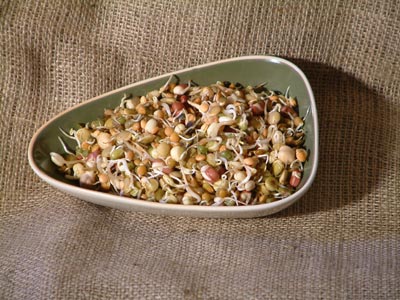Bean paste, different types of fermented beans with different seasonings, thinned with brine or oil to allow them to be used as a sauce.

Bean sprouts are a common ingredient in many eastern dishes and for salads, they are the crisp, tender sprouts of various beans, produced by placing them in a little water and allowing them to germinate. They are best eaten raw and are a good salad ingredient for winter time. They can also be stir fried or sautéed but for not more than half a minute. The beans most commonly used are soya, mung, adzuki and curd beans though there are many others which can be used. Crisp-looking sprouts with the seeds still attached should be chosen and they should be used quickly as they do not store well. In Delhi, the cook of the house where we stayed soaked mung beans, wrapped them in a muslin cloth and hung them in the kitchen overnight, dampening the cloth again in the morning, using the sprouts in the evening in cooked dishes.
Cellophane noodles. Wiry, hard, translucent noodles made with seaweed and mung bean flour which, before cooking, resemble a bundle of shredded cellophane.
Cellophane noodles. Wiry, hard, translucent noodles made with seaweed and mung bean flour which, before cooking, resemble a bundle of shredded cellophane.
The bearberry or American cranberry is a small, hard, red berry, rather similar to the cranberry, with a waxy coating and very tart flavour. It is produced on low growing vines in bogs in the north of North America and is used extensively in sauces with poultry.
Beard describes both the gills of an oyster, removed before eating, and the debris surrounding the rims of mussels after they have been taken from the rocks. It is the remnant of the byssus and should always be removed before cooking. It can also be the verb "to beard" - to remove the beard.